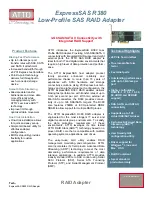
Installing the InformaCast Enabled Paging Adapter
Restore the Factory Default Settings
Operations Guide
931767B
CyberData Corporation
30
Backup SIP Server 2
Enter a second backup SIP server address as an IPv4 address in dotted decimal
notation or a fully qualified domain name. This parameter also becomes the host
portion of the SIP-URI for the device's extension on the second backup SIP server.
This field can accept entries of up to 255 characters in length.
Backup SIP User ID 2
Specify the SIP User ID for the second backup SIP Server. This parameter becomes
the user portion of the SIP-URI for the device's extension on the second backup SIP
server. Enter up to 64 alphanumeric characters.
Backup SIP Auth ID 2
Specify the Authenticate ID for the second backup SIP server. This parameter is
required for SIP registration authentication. Enter up to 64 alphanumeric characters.
Backup SIP Auth Password 2
Specify the Authenticate Password for the second backup SIP server. This parameter
is required for SIP registration authentication. Enter up to 64 alphanumeric
characters.
Remote SIP Port
The Remote SIP Port is the port number the device will use as the destination port
when sending SIP messages. The default Remote SIP Port is 5060. The supported
range is 0-65536. Enter up to 5 digits.
Local SIP Port
The Local SIP Port is the port number the device will use to receive SIP messages.
The default Local SIP Port is 5060. The supported range is 0-65536. Enter up to 5
digits.
Outbound Proxy
Enter the Outbound Proxy address as an IPv4 address in dotted decimal notation or
a fully qualified domain name (FQDN). When an IP address is configured, the device
will send all SIP messages to this IP address. When an FQDN is configured, the
device will run DNS NAPTR, SRV, and A queries on the FQDN to resolve an IP
address to which it will send all SIP messages. This field can accept entries of up to
255 characters in length.
Outbound Proxy Port
The Outbound Proxy Port is port number used as the destination port when sending
SIP messages to the outbound proxy. A value of 0 will default to 5060. The supported
range is 0-65536. Enter up to 5 digits.
Disable rport Discovery
Disabling rport Discovery will prevent the device from including the public WAN IP
address and port number in the contact information that is sent to the remote SIP
servers. This will generally only need to be enabled when using an SBC or SIP ALG
in conjunction with a remote SIP server.
Buffer SIP Calls
Also referred to as "delayed paging." Device will buffer up to four minutes of audio
then play back the recording after hang up or after the buffer is full.
Note
: Pressing the '#' key while recording a buffered SIP call will end the call and
cancel the page before it is sent.
Re-registration Interval (in seconds)
The SIP Re-registration interval (in seconds) is the SIP Registration lease time, also
known as the expiry. The supported range is 30-3600 seconds. Enter up to 4 digits.
Unregister on Boot
When enabled, the device will send one registration with an expiry of 0 on boot.
Keep Alive Period
The minimum time in milliseconds between keep-alive packets sent for nat traversal.
A value of 0 will disable keep alive packets.
RTP Settings
RTP Port (even)
Specify the port number used for the RTP stream after establishing a SIP call. This
port number must be an even number and defaults to 10500. The supported range is
0-65536. Enter up to 5 digits.
Table 2-8. SIP Configuration Parameters (continued)
Web Page Item
Description
















































